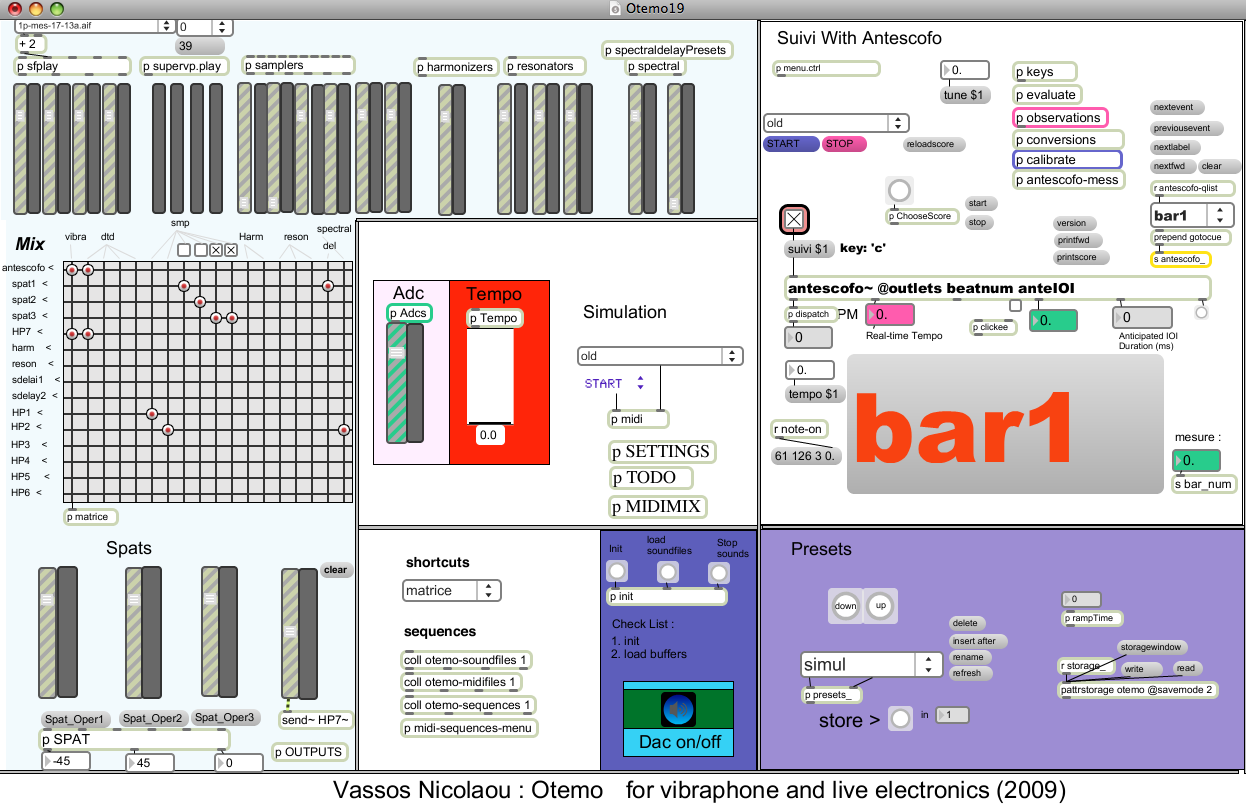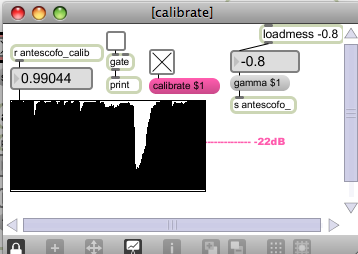Table of contents
Performance date: 17 juin 2009 - First performance
Documentation date: 17 juin 2009
Version state
Valid
Validation date: 3 mai 2018
Executions dates of this version
- 17 juin 2009,
Version documentalist
Version realisation
- Serge Lemouton (Computer Music Designer)
Version length
10 mnNo other version available
Detailed staff
- 1 vibraphone
Electronic equipment list
Computer Music Equipment
-
1 MacPro - Apple Desktops
(Apple)
-
1 Max/MSP - Max
(Cycling74)
version 5.0.7 -
1 UFX - Sound Board
(RME)
-
1 BCF 2000 - MIDI Mixer
(Behringer)
Audio Equipment
-
2 SM 57 - Dynamic Microphones
(Shure)
Mixed on mono for score following and transformations -
2 DPA 4061 - Condenser Microphones
(DPA)
For sound renforcement -
1 Amplifier - Amplification
-
8 Loudspeaker - Loudspeakers
Work related information
Premiere
- 17 juin 2009, Paris, musée d'Orsay, festival Agora
Publisher :
- Inédit
Realisation
- Serge Lemouton
Work length
- 10 mn
Event
- Concert "Segui" - mer 17 Jui 2009 - Auditorium du musée d'Orsay - Agora 2009
Useful links on Brahms
- Otemo pour vibraphone et électronique (2009), 10mn
- Vassos Nicolaou
| File | Author(s) | Comment | |
|---|---|---|---|
| Download [570,4 Mio] | Sound banks otemo sound banks | serge Lemouton | Sampler programs and sounds required to play the piece |
| Download [59,1 Mio] | Patch otemo max patch | serge Lemouton | Max MSP patch and libraries |
| Download [538,0 Mio] | Simulation files otemo-recordings | Daniel Ciampolini | Recordings of the vibraphone part to test the patch |
Instructions
Loudspeaker setup

Software installation
The Otemo folder contains 2 directories :
-
otemo-pat contains the max patch, and all the abstractions and external objects required.
-
otemo-machfive contains the sampler banks that are loaded into the max patch using the samplor~ object. The Motu MachFive software sampler is not required to run the the patch,it is only used to edit the sampler banks.
Launch Max5 (version 5.07)
set the File Preferences to the following folders (and their subfolders):
-
otemo-pat/lib
-
otemo-machfive
set the DSP Status to :

Patch presentation
open the Otemo19 patch

Initialization routine
- clic on the Init Bang
- turn the Dac On
- select the antescofo Score for the first section "otemo-Aj-090608+tournes.ascovassos.txt" in the Menu on the "Suivi With Antescofo" section of the main patch.
- stop the score follower (just below the menu)
- When the vibraphonist is ready to play the piece, start the score follower.
Keyboard Commands
The following keys on the numeric keypad are used to control the patch during the execution :
- 0 : stop the score follower
- . : start the score follower
- enter : advance to next bar
System calibration and tests
For the audio score following, two microphones (SM57 type) are set 15 cm below the vibraphone keys :

Open the "patcher calibrate" to adjust the level of the mix of these microphones

Put the calibrate toggle on : the multislider should be high (as on the picture) and go below -22dB only for real silences.
Performance notes
You should monitor the score follower during the execution, in order to recover some eventual mistakes. For this purpose, use the computer keyboard (see the keyboard shortcuts section)
© IRCAM

This documentation is licensed under a Creative Commons Attribution-NonCommercial-NoDerivatives 4.0 International License.
Program note
Cette pièce s’inspire de l’architecture chaotique de Tokyo et du sens de l’ordre particulier qui en résulte.
Elle commence par plusieurs motifs de rythmes harmoniques, superposés et projetés dans des champs harmoniques. Chaque événement musical possède sa propre vitesse ; de nombreux changements de tempos surgissent donc au cours de la pièce. Des permutations dans l’ordre des événements eux-mêmes se produisent fréquemment, dessinant des sortes de boucles dissimilaires et créant ainsi un cercle vertueux. En principe, plus le tempo est lent, plus le jeu devient rapide, et plus un grand nombre d’informations est transmis. Les brusques changements et coupures désorientent la perception, puis la mémoire. Vers la fin de la première partie, la musique se dissipe dans un silence presque total.
La deuxième partie est plus systématique, sans présenter pour autant de répétitions exactes. Les images de « miroirs déformants » du matériau du vibraphone sont données sur différents registres par l’électronique. La pièce se termine en jeu mécanique, voire robotique. Grâce au logiciel de suivi de partition Antescofo, l’ordinateur suit le musicien et ajuste la coordination avec l’électronique. Dans la partie électronique, tous les paramètres de temps sont contrôlés constamment par la vitesse réelle du musicien.
Vassos Nicolaou, programme de la création, Agora 2009.
Version documentation creation date: None, update date: 6 mai 2021 15:10